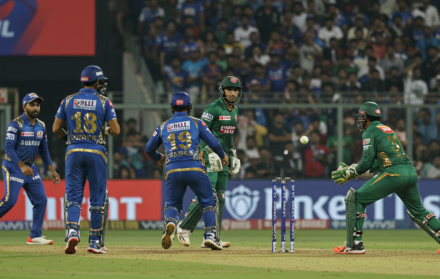
How To Build Winning Team Chemistry In Cricket
Team chemistry plays a crucial role in the success of a cricket team. It involves the bond, understanding, and synergy among team members, which directly impacts their communication, coordination, and overall performance. Enhancing team chemistry in cricket is vital for achieving collective goals and fostering a positive and supportive environment.
Factors that contribute to winning team chemistry include shared goals and values, effective leadership, clear roles and responsibilities, open and respectful communication, and team building activities. Incorporating these elements helps in building trust, camaraderie, and a sense of belonging within the team.
To build team chemistry in practice, it is essential to establish a strong team culture that promotes collaboration and support. Encouraging open communication and addressing conflicts promptly can further strengthen team dynamics. Creating a positive and inclusive environment fosters a sense of unity and camaraderie among team members.
Looking at successful examples of team chemistry in cricket can serve as inspiration and learning opportunities. Analyzing case studies can provide valuable insights into the strategies and dynamics that contribute to the success of a team.
Here are some tips for building winning team chemistry in cricket: fostering relationships off the field, developing effective communication strategies, encouraging accountability and responsibility, and celebrating achievements while learning from failures. By implementing these strategies, cricket teams can enhance their team chemistry and improve their performance both on and off the field.
The Importance of Team Chemistry in Cricket

In the world of cricket, team chemistry can be the ultimate game-changer. It goes beyond the skills and talents of individual players, creating a unique synergy that propels a team to victory. In this section, we’ll explore the significance of team chemistry in cricket.
From enhancing communication and coordination to fostering trust and camaraderie, and even boosting performance and morale, we’ll uncover the power behind a tightly-knit team on the cricket pitch.
So, get ready to unlock the secrets of what it truly takes to build a winning team in this exhilarating sport.
Enhances Communication and Coordination
Effective team chemistry in cricket greatly enhances communication and coordination, ultimately resulting in improved performance on the field. This can be achieved through several strategies, including clear and open lines of communication between team members, allowing for effective sharing of information and strategies.
Additionally, regular team meetings and huddles are essential to discuss game plans and tactics, ensuring that everyone is on the same page.
Practice sessions focused on teamwork and coordination, such as fielding drills and running between wickets, also contribute to enhancing communication and coordination.
Building trust among teammates is equally important, as it fosters an environment where everyone feels comfortable expressing their opinions and ideas.
An excellent example of the impact of effective communication and coordination in cricket was demonstrated by the England cricket team in the final against New Zealand during the 2019 Cricket World Cup.
The team showcased exceptional teamwork and coordination, particularly highlighted by a stunning run-out executed in the super over. This remarkable display of strong team chemistry ultimately enabled them to clinch the title.
Encourages Trust and Camaraderie
Encouraging trust and camaraderie is crucial for building successful team chemistry in cricket. This bond among teammates fosters cooperation and unity, ultimately leading to improved performance on the field. Here are some ways in which trust and camaraderie can be encouraged:
- Open Communication: Promote an environment where players feel comfortable expressing their thoughts and concerns.
- Team Bonding Activities: Organize regular team-building exercises and events to strengthen relationships and create shared experiences.
- Support and Encouragement: Foster an atmosphere where teammates genuinely support and uplift each other, both in practice and during matches.
- Inclusive Environment: Ensure that all players are treated with respect and inclusion, regardless of their skill level or background.
By encouraging trust and camaraderie, cricket teams can cultivate a positive team culture that encourages trust and camaraderie, enhancing their performance and ultimately leading to success.
Boosts Performance and Morale
Boosting performance and morale is crucial for a winning cricket team. Here are some strategies to enhance team chemistry:
- Effective Communication: Encourage open and respectful communication among team members to ensure effective coordination and collaboration.
- Positive Environment: Foster a positive and inclusive environment where players feel supported and valued, which can significantly improve their performance and morale.
- Team Bonding: Organize team-building activities off the field to foster relationships and strengthen the bond between players.
- Recognition and Celebrations: Celebrate achievements and milestones to boost morale and motivate players to perform at their best.
And remember, a united team is more than just talented individuals, it’s a group that supports and uplifts each other, ultimately leading to enhanced performance and high morale.
Factors That Contribute to Winning Team Chemistry

Building a winning team chemistry in cricket goes beyond just individual skills on the field. It’s about creating a bond, a connection that brings out the best in each player. In this section, we’ll uncover the factors that contribute to this winning chemistry.
From shared goals and values to effective leadership, clear roles and responsibilities to open and respectful communication, and even team building activities.
Get ready to uncover the secrets behind successful cricket teams and how they foster a cohesive and harmonious environment.
Shared Goals and Values
- Shared vision: Teams with strong chemistry have a common goal and shared values, which are the foundation of their success.
- Trust and mutual respect: Team chemistry thrives when members trust and respect each other’s shared goals and values. They value each other’s opinions, support one another, and foster a positive and inclusive environment.
- Effective communication: Open and transparent communication is vital for building team chemistry. Teams that communicate effectively can share ideas, resolve conflicts, and make collective decisions based on their shared goals and values.
- Collaboration and cooperation: Successful teams foster a culture of collaboration and cooperation centered around their shared goals and values. They work together, leverage individual strengths, and help each other succeed.
- Accountability and commitment: Teams with strong chemistry hold themselves accountable for their actions and commitments related to their shared goals and values. They take ownership of their roles and responsibilities, leading to a high level of commitment towards achieving these shared goals.
Effective Leadership
- Leading by example: An effective captain or coach who demonstrates a robust work ethic and unwavering dedication serves as a source of inspiration for their team, encouraging them to mirror these qualities.
- Clear and consistent communication: A leader should communicate in a precise and consistent manner, ensuring that every team member comprehends their assigned role and responsibilities.
- Skillful decision-making: Leaders must make well-informed decisions that benefit the entire team, taking into account diverse perspectives and remaining open to feedback.
- Motivation: Leaders ought to motivate their team members by establishing achievable goals and cultivating a positive environment that enhances team spirit and morale.
- Empathy and support: A competent leader understands the needs of their players and offers emotional support whenever necessary, thereby fostering an inclusive and supportive atmosphere.
By embodying these characteristics, a leader can cultivate team chemistry, thereby guiding their team to success both on and off the field.
Clear Roles and Responsibilities
- Clear roles and responsibilities are crucial for successful team chemistry in cricket.
- Each team member should have a specific role and understand their responsibilities on the field.
- Roles can include opening batsmen, middle-order batsmen, pace bowlers, spin bowlers, wicketkeepers, and fielders.
- This clarity helps enhance communication, coordination, and overall performance.
- It ensures that everyone knows what is expected of them and reduces confusion or conflicts during a match.
To establish clear roles and responsibilities:
- Engage in open discussions and assign roles based on individual strengths and talents.
- Regularly communicate and review roles to adapt to changing conditions or strategies.
- Promote a culture of accountability where everyone takes ownership of their responsibilities.
- Provide clear guidelines and expectations to avoid misunderstandings.
Open and Respectful Communication
Open and respectful communication is essential for fostering strong team chemistry in cricket. It plays a critical role in allowing players to understand each other, share ideas, and work towards a common goal. Here are some effective ways to promote open and respectful communication within a cricket team:
Encourage active listening: Motivate team members to actively listen to one another, ensuring that everyone’s opinions are heard and valued.
Highlight the importance of clear and concise communication: Stress the significance of clear and concise communication to avoid misunderstandings and promote effective team coordination.
Promote constructive feedback: Encourage players to provide feedback in a positive and constructive manner, focusing on improvement rather than criticism.
Create an environment that encourages open dialogue: Foster a safe and inclusive environment where players feel comfortable expressing their thoughts and ideas openly.
Conduct regular team meetings: Organize regular team meetings to discuss strategies, address concerns, and provide updates, enabling open discussions among team members.
Team Building Activities
- Icebreaker games: These team building activities help players get to know each other better, build trust, and create a positive team environment.
- Problem-solving challenges: Engaging in team building activities that require collaboration and problem-solving skills can enhance communication and teamwork.
- Physical challenges: Team building activities such as obstacle courses or relay races promote teamwork, boost morale, and build camaraderie.
- Team bonding events: Organizing outings or social events outside of cricket helps teammates develop stronger relationships and improve team dynamics through team building activities.
- Goal-setting exercises: Team-building activities that involve setting shared goals and working towards achieving them foster unity and motivation.
Building Team Chemistry in Practice

When it comes to building a winning team in cricket, establishing strong team chemistry is essential. In this section, we’ll uncover the key elements of building team chemistry in practice.
From establishing a strong team culture to encouraging collaboration and support, fostering a positive and inclusive environment, and addressing conflicts, we’ll explore how each of these sub-sections contributes to creating a cohesive and high-performing cricket team.
So, let’s dive in and discover the secrets behind building a winning team chemistry on the cricket field!
Establishing a Strong Team Culture
Establishing a strong team culture is vital for promoting high-performance and cohesion in cricket teams. Here are some essential elements to take into account:
- Clear values and vision: Clearly define the team’s values and goals to create a shared sense of purpose.
- Effective communication: Foster open and honest communication to cultivate trust and understanding among team members.
- Shared rituals and traditions: Establish team rituals or traditions that foster unity and cultivate a sense of belonging.
- Positive reinforcement: Acknowledge and celebrate individual and team accomplishments to enhance morale and motivation.
- Support and inclusivity: Cultivate an environment where everyone feels valued and supported, thus promoting collaboration and cooperation.
By implementing these strategies, teams can build a robust team culture that contributes to their overall success.
Encouraging Collaboration and Support
Encouraging Collaboration and Support is crucial for building effective team chemistry in cricket. Team members who work together and support each other are more likely to achieve success. Here are some strategies to foster collaboration and support within the team:
- Establish a culture of teamwork: Encourage players to prioritize the team’s goals over individual achievements.
- Promote open communication: Create an environment where players feel comfortable expressing their ideas and concerns.
- Encourage cooperation: Emphasize the importance of supporting and helping each other both on and off the field.
- Develop trust: Build trust among team members by promoting transparency and accountability.
- Provide constructive feedback: Encourage players to give feedback to one another in a respectful and constructive manner.
- Celebrate team successes: Recognize and celebrate team achievements to boost morale and promote a sense of unity.
- Support personal growth: Encourage players to develop their skills and offer mentorship opportunities within the team.
Fostering a Positive and Inclusive Environment
Creating a positive and inclusive environment is crucial for nurturing strong team chemistry in cricket.
- Promoting respect: We should encourage players to show respect for each other’s opinions, ideas, and differences.
- Establishing a safe space: Our aim is to foster an environment where players feel at ease expressing themselves without any fear of judgment or discrimination.
- Highlighting collaboration: By promoting open communication and decision-making shared among the team members, we can encourage teamwork and cooperation.
- Inclusivity matters: We need to ensure that every player feels included and valued, regardless of their background, skills, or experience.
- Addressing conflicts: It is crucial to promptly deal with any conflicts or issues that may arise within the team, promoting resolution and understanding.
Through fostering a positive and inclusive environment, teams can elevate trust, cohesion, and overall performance, consequently leading to success in cricket.
Addressing and Resolving Conflicts
Addressing and resolving conflicts is crucial for maintaining a harmonious team chemistry in cricket. Here are steps to effectively handle conflicts in a team:
- Recognize the conflict: Identify the issue or disagreement that is causing tension within the team.
- Listen actively: Give each team member involved an opportunity to express their thoughts and concerns.
- Encourage open communication: Foster an environment where team members feel comfortable discussing the conflict openly and honestly.
- Seek a resolution: Collaboratively work towards finding a solution that satisfies all parties involved.
- Maintain respect and professionalism: Encourage team members to address the conflict in a respectful and calm manner.
- Follow up: After addressing and resolving the conflict, check in with the team members involved to ensure that the issue has been fully resolved.
In a famous incident during the 2005 Ashes series, there was a conflict between English cricketers Kevin Pietersen and Matthew Hoggard. They had a heated argument on the field but eventually addressed the conflict through open communication and teamwork, leading to a stronger team chemistry and a victory for England.
Examples of Successful Team Chemistry in Cricket

Successful team chemistry is crucial in cricket, and looking at case studies can provide valuable insights. Here are some examples of teams with exceptional chemistry:
- The Australian cricket team in the late 1990s, known for their strong camaraderie and shared focus on success.
- The Indian cricket team under the leadership of MS Dhoni, where players supported and trusted each other, leading to numerous victories.
- The New Zealand cricket team, known for their unity, mutual respect, and selflessness on and off the field.
- The West Indies cricket team during their dominant phase in the 1970s, exemplifying the power of teamwork and collective spirit.
To cultivate team chemistry, it is essential to prioritize open communication, foster a positive team culture, and celebrate individual and collective successes. Encouraging team-building activities and addressing conflicts promptly also contribute to a strong team bond.
By examining these case studies of successful team chemistry in cricket, teams can learn valuable lessons on fostering team chemistry for better performance.
Tips for Building Winning Team Chemistry
Building a winning team chemistry in cricket requires more than just individual talent on the field. In this section, we’ll explore valuable tips that can help teams foster strong relationships off the field, develop effective communication strategies, encourage accountability and responsibility, and celebrate achievements while learning from failures.
By implementing these strategies, cricket teams can enhance their cohesion, unity, and ultimately improve their performance on the pitch.
So, let’s delve into the key ingredients for creating a winning team chemistry in cricket!
Foster Relationships Off the Field
Fostering relationships off the field is crucial for building strong team chemistry in cricket.
- Organize team-building activities outside of cricket, such as group dinners or team outings.
- Encourage social interactions among team members to build trust and camaraderie.
- Invest time in getting to know each other on a personal level and promoting a supportive environment.
- Communicate and collaborate beyond the playing field to strengthen bonds and understanding.
Building relationships off the field creates a foundation of trust and unity that translates into improved performance on the field.
Remember, winning team chemistry is not just about the game; it’s about fostering meaningful connections and building a strong team culture.
Develop Effective Communication Strategies
Developing effective communication strategies is essential for building strong team chemistry in cricket. Here are some key tips to enhance communication within the team:
- Encourage open and honest communication among teammates to facilitate the exchange of ideas and feedback.
- Implement clear and concise communication channels to ensure everyone is on the same page.
- Foster active listening skills to promote understanding and empathy among team members.
- Emphasize the importance of non-verbal communication in conveying messages on the field.
- Regularly review and evaluate the effectiveness of communication strategies to identify areas for improvement.
Pro-tip: Incorporate team-building exercises that focus on communication skills, such as role-playing scenarios, to enhance interaction and collaboration within the team.
Encourage Accountability and Responsibility
Encouraging accountability and responsibility is crucial for building winning team chemistry in cricket.
Here are some steps to promote accountability and responsibility within a cricket team:
- Set clear expectations and goals for individual players.
- Ensure that each player understands their role and responsibilities within the team.
- Encourage open and honest communication to address any issues or challenges.
- Establish a system of regular feedback and evaluation to assess individual performance.
- Promote a culture of taking ownership for mistakes and learning from them.
Here are some suggestions to foster accountability and responsibility:
- Lead by example and demonstrate accountability and responsibility in your own actions.
- Provide support and resources for players to help them fulfill their responsibilities.
- Recognize and reward players who consistently show accountability and responsibility.
- Offer opportunities for professional development and growth to empower players to take ownership of their roles.
By implementing these steps and suggestions, cricket teams can cultivate a sense of accountability and responsibility, leading to improved team chemistry and performance.
Celebrate Achievements and Learn from Failures
Celebrating achievements and learning from failures are crucial steps in building winning team chemistry in cricket.
- Celebrate achievements: Acknowledge and appreciate individual and team accomplishments, whether it’s a milestone reached, a match won, or a personal best performance.
- Reflect on failures: Use failures as opportunities for growth and improvement. Analyze what went wrong, identify areas for development, and learn from mistakes.
- Create a positive environment: Foster a culture of support and encouragement where players feel comfortable sharing both their successes and failures.
- Review and adapt strategies: After celebrating achievements and reflecting on failures, evaluate team strategies and make necessary adjustments to enhance future performance.
- Emphasize continuous learning: Encourage players to constantly learn and improve, both individually and as a team, by seeking feedback, attending workshops, and studying the game.
Frequently Asked Questions
How important is team chemistry in cricket?
Team chemistry is extremely important in cricket as it can significantly impact the success of a team throughout a season. High-performing teams with strong chemistry often outperform mediocre teams.
What are some measurable factors that contribute to team performance?
Researchers have identified five measurable factors that drive team performance: equal participation in conversations, high levels of eye contact, direct communication between team members, back-channel or side conversations, and sharing information brought in from outside the team.
How can team captains build and maintain team chemistry?
Team captains have a crucial role in fostering team chemistry. They can build trust and unity by establishing a culture of trust and safety, leading by example, maintaining a positive atmosphere, encouraging open communication, fostering teamwork, and providing opportunities for team members to bond and connect.
What are the 10 R’s in improving team unity?
The 10 R’s provide a starting point for discussions on improving team unity. They consist of five pairs of words starting with the letter R: Roles and Rules, Relationships and Respect, Reassurance and Reasons, Clear Communication and Effective Leadership.
How can coaching staff contribute to team unity?
The coaching staff plays a vital role in improving team unity. Their responsibility is to unify and maintain the team’s unity. Working closely with the coaching staff and following their guidance can lead to significant improvements in team chemistry.
Is there a cost-effective way to improve team unity in cricket?
A cost-effective way to improve team unity in cricket is to engage the services of a qualified sport psychologist. While it may incur some expense, working with a sport psychologist can provide valuable insights and techniques to enhance team cohesion and manage emotions effectively.





